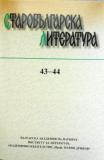Реликти от стара практика: някои наблюдения върху аранжирането на репертоара на ранните кондаци
Relicts of an Old Practice: Some Observations on the Arrangement of the Repertory of Early Kontakia
Author(s): Svetlana KujumdzievaSubject(s): Music
Published by: Институт за литература - БАН
Summary/Abstract: RELICTS OF AN OLD PRACTICE: SOME OBSERVATIONS ON THE ARRANGEMENT OF THE REPERTORY OF EARLY KONTAKIA SVETLANA KUJUMDZIEVA (SOFIA) (S u m m a r y) On the focus of the article is the repertory of kontakia that are arranged for the whole ecclesiastical year and are included in the book of the Psaltikon. The latter was in use between 11th and 14th century and was designated for the performance of soloists for the cathedral rite of the secular churches, known as “sung Office”. The study of the kontakia in the Greek Psaltikons shows that in terms of the arrangement they resemble the repertory of one of the earliest hymnographic books preserved in Georgian copies, the so-called Iadgari, the book that goes back as early as the 6th/7th century and presents the cathedral rite of Jerusalem. Like the repertory of the Iadgari, the kontakia in almost all of the Greek Psaltikons are arranged in an uninterrupted order: the yearly cycle of both the fixed feasts for the twelve months throughout the liturgical year and the movable feasts for the periods of Lent, Easter, and Pentecost are interspersed in a single calendar sequence. The movable feasts are placed between February 2, the Hypapante, and June 24, the feast of St. John Prodromos. The first two weeks of the preparatory period of Great Lent – of the Publican and Pharisee and of the Prodigal Son – are missing. The movable cycle starts with the Meatfare Sunday – a fact that is established for all of the older hymnographic books containing the repertory of Great Lent. The arrangement of the kontakia in the Psaltikons reveals that they have preserved an archaic tradition that goes back before the 9th century. The study of the Slavic kontakia preserved in five Old-Slavic Kontakaria from the 11th to the 14th century, shows that they are arranged according to the “newly” “interrupted” order: the yearly cycle is divided into two separate cycles containing, respectively, fixed and movable feasts. The movable cycle starts like the Greek Psaltikons with the Meatfare Sunday. The existence of two different practices of the arrangement of the repertory of the kontakia between 11th and 14th century – an older one and a new one – speaks about the use of different Typika. It is very possible that the newer arrangement of the kontakia in the Old-Slavic Kontakaria appeared as a result of the activity of the Studite shool of poet-composers from the 9th century onwards: it is almost sure that the Studite monks rearranged the repertory of the kontakia dividing it into separate cycles of fixed and movable feasts. Hence the Old-Slavic Kontakaria in terms of the arrangement of the kontakia for the whole ecclesiastical year represent a later stage in the development of the repertory of kontakia.
Journal: Старобългарска литература
- Issue Year: 2010
- Issue No: 43-44
- Page Range: 194-208
- Page Count: 15
- Language: Bulgarian
- Content File-PDF

